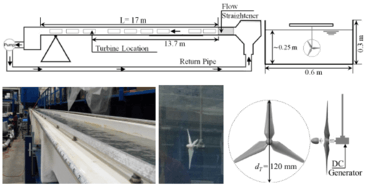
Schematic of a test flume and rotor location (top); and photographs of a flume and schematic of the rotor are on the lower part of the image.
Sandia Labs Water Power Technologies Department promotes open-source marine hydrokinetic research by disseminating information on MHK technology designs initially developed as reference models to benchmark performance and costs. Sandia developed a scale model of a reference hydrokinetic turbine to minimize power performance losses from soiling/biofouling, and reduce the likelihood of cavitation.
Researchers at the University of Illinois Ven Te Chow Hydrosystems Laboratory recently tested the model to evaluate the potential effects of hydrokinetic turbines on erosion of riverbeds and tideways. The test data quantified the near-bed flow characteristics and the bed shear stress as indicators of bed erosion. Results show that the bed shear stress is sensitive both to the distance from the rotor and to the relative height of the rotor. Maximum bed shear stress occurred downstream of the rotor with the rotor closer to the bed.
Flow statistics show a reduction of turbulence intensity and turbulent shear stress near the wall and close to the rotor due to flow acceleration and changes in the pressure distribution. Spectral analysis of the streamwise velocity indicates a reduction of the energy content across scales spanning two orders of magnitude right below the turbine. The increase of bed shear is predominantly due to flow acceleration rather than turbulence.
Details were published in the report, On the Near-wall Effects Induced by an Axial-flow Rotor.
Filed Under: News, Offshore wind




